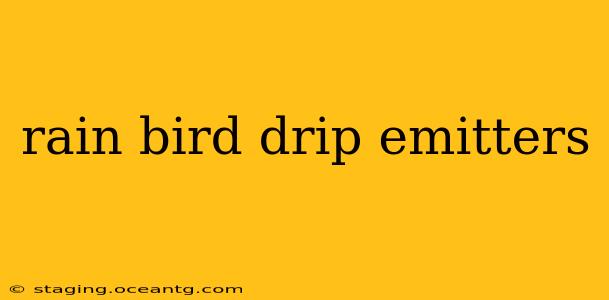Rain Bird is a leading name in irrigation, and their drip emitters are a popular choice for efficient and water-wise gardening. This guide delves into the world of Rain Bird drip emitters, covering everything from their various types and applications to installation tips and troubleshooting common problems. Whether you're a seasoned landscaper or a weekend gardener, this resource will help you understand and utilize these essential irrigation components effectively.
What are Rain Bird Drip Emitters?
Rain Bird drip emitters are small devices that deliver water slowly and directly to the roots of plants. Unlike spray sprinklers that can lead to water waste through evaporation and runoff, drip emitters conserve water by precisely targeting the plant's water needs. This targeted approach promotes healthier plant growth and reduces the amount of water used in irrigation. They are available in a variety of flow rates and pressure compensations, making them suitable for a wide range of applications, from small flowerbeds to large-scale landscaping projects.
Different Types of Rain Bird Drip Emitters
Rain Bird offers a wide variety of drip emitters, each designed for specific needs and applications. Understanding the differences is crucial for selecting the right emitter for your project. Some common types include:
-
In-line Drip Emitters: These are simple, low-cost emitters that are inserted directly into the tubing. They're ideal for straightforward applications where uniform watering is sufficient.
-
Pressure-compensating Drip Emitters: These emitters maintain a consistent flow rate even with variations in water pressure throughout the irrigation system. This is particularly beneficial for systems with uneven terrain or long runs of tubing.
-
Adjustable Drip Emitters: These allow you to fine-tune the water flow rate to meet the specific needs of different plants. This is useful when you have a mix of plants with varying water requirements in the same area.
-
Barb Drip Emitters: These emitters have barbs that puncture the tubing, providing a quick and easy installation method. They're commonly used for temporary or smaller irrigation setups.
How to Choose the Right Rain Bird Drip Emitter
Choosing the right emitter depends on several factors:
-
Water Pressure: Know your water pressure to select an emitter that operates efficiently within that range. Pressure-compensating emitters are recommended for inconsistent pressure.
-
Flow Rate (GPH): This determines how much water each emitter delivers per hour. Consider the water needs of your plants and the spacing between emitters to calculate the required GPH.
-
Application: The type of plants, soil conditions, and the overall design of your irrigation system will influence the type of emitter best suited for your project.
-
Budget: While some emitters are more expensive than others, the long-term benefits of efficient watering often justify the investment in higher-quality, pressure-compensating models.
How to Install Rain Bird Drip Emitters
Installation typically involves:
-
Planning your layout: Map out the placement of your drip emitters based on your plants' needs and water pressure.
-
Laying the tubing: Run the tubing along the planned routes, ensuring it's level to maintain consistent water flow.
-
Attaching the emitters: Use the appropriate method for your chosen emitter type (piercing, barb, or fitting).
-
Testing the system: Turn on the water and check for leaks or areas with inconsistent water flow.
Troubleshooting Common Rain Bird Drip Emitter Problems
-
Clogged Emitters: Regularly flush your system to remove debris.
-
Inconsistent Water Flow: Check for leaks, clogged emitters, and uneven water pressure.
-
Low Water Pressure: This could be due to a problem with your main water supply or a kink in the tubing.
-
Emitters Not Working: Inspect the emitter connections and check if there's a blockage.
What is the best Rain Bird drip emitter?
There isn't a single "best" Rain Bird drip emitter. The optimal choice depends entirely on your specific needs and the conditions of your irrigation system. Factors like water pressure, desired flow rate, and the type of plants being watered all play a crucial role in determining the most suitable emitter. Consulting a professional or using Rain Bird's online resources to assess your system's requirements will help you make an informed decision.
How do I calculate GPH for Rain Bird drip emitters?
Calculating the GPH (gallons per hour) for your Rain Bird drip emitters requires considering the water requirements of your plants and the spacing between the emitters. Rain Bird provides resources and calculators on their website to assist in this process. You'll need to input factors such as the emitter spacing, the type of emitter used (and its individual GPH rating), and the total area you're irrigating.
What is the difference between pressure compensating and non-pressure compensating drip emitters?
Pressure-compensating drip emitters maintain a consistent flow rate even if the water pressure fluctuates throughout the irrigation system. Non-pressure compensating emitters, however, deliver a flow rate that varies directly with the water pressure. For systems with uneven terrain or long runs of tubing, pressure-compensating emitters are crucial for ensuring even water distribution to all plants. Non-pressure compensating emitters are generally more affordable but less consistent.
Are Rain Bird drip emitters easy to install?
The ease of installation depends on the type of emitter and the complexity of your irrigation system. Some emitters, like barb emitters, are designed for quick and easy installation by simply piercing the tubing. Others might require additional fittings or more technical expertise. However, in general, Rain Bird drip emitters are designed with user-friendliness in mind, and many basic installations can be tackled by homeowners with some basic DIY skills. Always refer to the manufacturer's instructions for your specific emitter model.
This guide provides a comprehensive overview of Rain Bird drip emitters. Remember to always consult the manufacturer's instructions for specific installation and maintenance details. By understanding the different types and their applications, you can create a highly efficient and water-conserving irrigation system for your garden.
